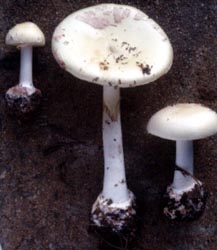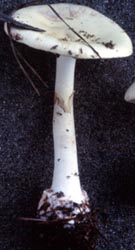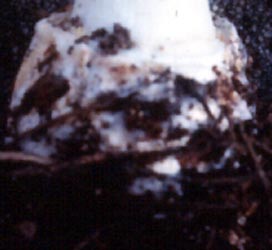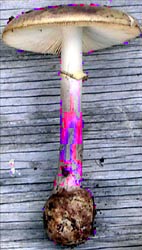|
[ Section Validae page. ]
[ Amanita Studies home. ]
[ Keys & Checklist/Picturebooks ] "Lavender Staining American Citrine Amanita "
Technical description (t.b.d.) BRIEF DESCRIPTION: Nomenclatural and taxonomic changes are very likely with regard to the present taxon at species rank and below. This page has been undergoing frequent updates in autumn, 2006. The following is based on the description by Coker (1917) with additions from personal observation of RET. The cap of A. citrina f. lavendula is 35 - 95 mm wide, light primrose yellow to nearly white with pale primrose yellow over the center, often with stains of light brown or lavender (e.g., in image on right in top row, above) or purple-lavender or a combination of these, with yellow colors becoming more intense in age or in situ drying and expanding over the entire cap, concave to plano-convex to planar, slightly depressed in the center in maturity, sometimes with a slight umbo in the depression, somewhat viscid when moist, shining when dry, nonappendiculate, with a nonstriate margin at first although sometimes distinctly striate at maturity. The volva is present as occasional, flat, irregular, gray or brown or lavender or pink-lavender patches; these may become rusty-brown with age. The flesh is nearly white, infrequently (probably controlled by environmental conditions) quickly turning lavender when cut, quite thin (e.g., up to 2 mm thick above the center of the gills; up to 5 mm thick above the stem). The gills are free but close to the stem and connected to the stem by a line that continues down the top of the stem. They are pure white in side view, not forked, and broadest (3.5 - 7 mm) in the middle. The short gills are plentiful. The stem is up to 100 × 6 - 19 mm, faint primrose yellow above the ring, nearly white below, sometimes with cream or brown or lavender tints, staining brown with handling, usually solid with no distinct central cylinder but sometimes hollow in part , smooth, and somewhat silky shiny. The bulb is proportionately large, abrupt, varying from globose to turnip-shaped, up to 27 × 41 mm wide, soft, spongy, sometimes marginate with short submembranous pieces of the volva, white on the inner surface. The surface of the volva and bulb may take on a distinct lavender or pinkish-lavender or brownish or gray coloration. The ring is primrose yellow (infrequently white), thin, delicate but membranous, placed on the stem 20 - 35 mm below the stem apex, often decorated on the lower side with fibrils formerly attached to the stem, and may fall away from the stipe and be lost or stay attached as a skirt. The ring may have lavender areas under appropriate conditions or turn gray with age. The odor is like raw green peanuts [or like freshly dug potatoes or freshly dug turnips] when the mushroom is cut. Spores of the present taxon measure: (6.3-) 6.4 -8.0 (-8.8) × (5.4-) 5.5 - 7.1 (-7.8) µm, globose to subglobose, and amyloid. As in all taxa of section Validae for which the character is reported, clamps are absent from the bases of basidia. The present form was originally described from North Carolina, USA, where it occurs commonly in pine (Pinus) forest and mixed woods including pine and oak (Quercus). Within its range, it is one of the last species of Amanita to be found at the end of the mushroom season in autumn or early winter. In addition to the possibility that it seems not to be contaxic with A. bulbosa var. citrina (Schaeff.) Gillet ("Schaeffer's Citrine Bulbous Amanita"), the interpretation of A. citrina in North America has other problems with both naming and taxonomy. The original description of the present taxon includes some material on which no lavender staining was seen according to Coker's annotation on the herbarium packets. RET's personal experience indicates that, without cold nights, many specimens of this mushroom show no lavender at all. Hence, it is possible that Coker's form lavendula includes some material that might also be included under Amanita brunnescens f. straminea E. J. Gilbert, which is a valid name for Amanita citrina in the sense of authors of northeastern North America ("American Citrine Amanita"). Indeed, Gilbert's taxon might be a synonym of f. lavendula. [Note: The name A. brunnescens is wrongly applied in the case of Gilbert's "form." The spores in the Gilbert taxon are larger than in lavender tinted specimens of A. citrina f. lavendula according to RET's type study of the former: (7.5-) 7.8 - 8.5 (-9.2) × (6.8-) 7.0 - 8.2 (-9.0) µm and experience to date with the latter.] In other words, Gilbert's taxon may be based on examples of A. citrina f. lavendula that showed no lavender staining. Brown and pinkish stains are common on the species known as "A. citrina" in and north of New Jersey, while lavender is infrequently seen on the "citrina" of this region unless the material is left in an unheated area on a cold night after collecting -- then lavender tints usually appear in one or more of the specimens so treated. Material that RET has personally collected in which a distinct lavender or purple-lavender coloration was present on the cap skin, the stipe's ring, the surface and flesh of the stem, and/or on the volva have been collected south of Virginia for the most part and after at least a short period of cold weather. Nevertheless, based on the cap's pale color, the spore size/shape, and recent frequency of collections with lavender on at least one fruiting body in the collection that has been exposed to cold after collecting, f. lavendula occurs commonly at least as far north as central New Jersey. (For more data on association of date of collection with presence of lavender, click here.) Based on limited experience, the lavender staining seems to RET to be much more common (certainly more widespread on the fruiting body) in specimens collected after a light frost or after a night when the temperature (allowing for windchill) has been below freezing. This suggest that environmental factors (presumably low temperature) are correlated with the accentuation of lavender tinted regions and lavender staining on freshly cut surfaces. A thorough revision (including type studies) of the "North American citrina group" is much needed, and molecular work on specimens that would fall in this group may produce valuable results.
As an experiment, we increased the saturation of magenta to the maximum (using Adobe Photoshop®) in a picture of A. citrina f. lavendula from near the South Carolina-Georgia border and did the same for a picture of a cap of A. bulbosa var. citrina (Schaeff.) Gillet from England. The combined illustrations are shown immediately above. Even at high magnification, the European specimen displayed very little magenta spotting and the North American specimen, as can be seen, has extensive areas of magenta and colors in which magenta is a significant component, especially in association with volva patches. Both pictures were taken on Kodachrome ASA 64 slide film with a Canon AE-1 camera in autumn or early winter (although at different latitudes). The pronounced difference is noticeable despite the fact that the film is not terribly sensitive to the lavender tints and failed to reproduce them well in photographs taken of specimens in which purplish lavender was a component of cap skin coloring. In addition, the lack of lavender was also present on A. bulbosa var. citrina caps that were less mature than the one pictured and in which the volva had not darkened so distinctly. There was no magenta visible in the flesh of sectioned fruiting bodies of the same taxon. There was also a very minimal reaction to maximum saturation of magenta in the case of A. bulbosa (Schaeff.) Lam. var. bulbosa. Note also the natural difference in saturation of color of the cap skin in young fruiting bodies between the European and North American taxa.
Recently collected material (2006, from North Carolina and Tennessee and showing the strongest lavender color RET has ever seen in the taxon) photographed with a digital camera (Olympus C-5500 Zoom) produced photographs that reacted to the hypermagenta test when there were distinct regions of lavender on the cap, the stem, or on exposed flesh (at right). Research on fruiting body chemistry (proteins) several years ago at the University of Tennessee, Knoxville, was unable to differentiate between lavender staining and non-lavender staining material from Tennessee and North Carolina on the basis of a set of proteins studied. On the other hand, comparison of the forms of hyphae and rate of hyphal growth in culture between a similar pair of sets of specimens showed a strong distinction, in research at the same university. A macroscopic review of September collections in North Carolina and Tennessee in 2006 (RET) suggests that all the material (lavender tinted or not may belong to a single taxon. This also seems to be true of the relatively large collections from central and southern New Jersey made in October 2006 (RET).-- R. E. Tulloss and L. Possiel Photos: R. E. Tulloss (South Carolina, near border
with Georgia, USA---except for specimen photographed with annotation,
which was collected in western North Carolina.).
[ Section Validae page. ]
[ Amanita Studies home. ]
[ Keys & Checklist/Picturebooks ] Last changed 22 March 2009. |







 We continued the experiment with additional photographs of A.
citrina f. lavendula taken in December at the same South
Carolina site. The same phenomena was observed -- significant
areas of the fruiting body (especially those that had seemed lavender to
the naked eye) became strongly magenta. One of the
photos from the site shows extensive lavender coloration over most of
the cap (first row, right, at the top of this page). In this case,
nearly the entire pileus became magenta as a result of the maximum
saturation experiment ("hypermagenta test") (left). To date,
the hypermagenta test has been applied with negative results only to photographs of material
from Europe (France, Norway and the United Kingdom) and to specimens of the current taxon on which no lavender could be detected by
the eye. We are very interested in testing
photographs (for which there are dried voucher specimens) from parts of Europe other than those cited above.
We continued the experiment with additional photographs of A.
citrina f. lavendula taken in December at the same South
Carolina site. The same phenomena was observed -- significant
areas of the fruiting body (especially those that had seemed lavender to
the naked eye) became strongly magenta. One of the
photos from the site shows extensive lavender coloration over most of
the cap (first row, right, at the top of this page). In this case,
nearly the entire pileus became magenta as a result of the maximum
saturation experiment ("hypermagenta test") (left). To date,
the hypermagenta test has been applied with negative results only to photographs of material
from Europe (France, Norway and the United Kingdom) and to specimens of the current taxon on which no lavender could be detected by
the eye. We are very interested in testing
photographs (for which there are dried voucher specimens) from parts of Europe other than those cited above.
